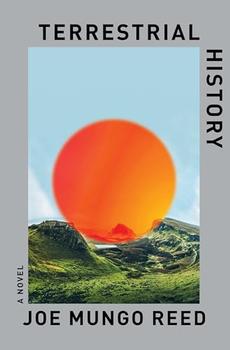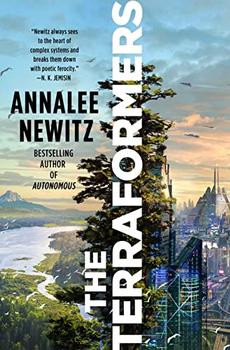Summary | Excerpt | Reviews | Beyond the book | Read-Alikes | Genres & Themes | Author Bio

A Novel
by Joe Mungo ReedIn 2025, a renowned fusion scientist named Hannah is working alone at her seaside cottage in Scotland, hoping for a breakthrough in her search for a clean energy source. One day, while sitting on the beach with her dog, Jasper, she sees something strange: a dark, golem-like figure emerging from the water. She is frightened at first; however, when Jasper approaches the figure, it kneels and puts a hand out for him to sniff. When Hannah finally gets a good look, she discovers that it is indeed a human: "… there, hanging like a bug stuck in amber, was the glowing face of a young man: boyish, freckled. He blinked. He smiled down at me." The young man in the strange suit tells Hannah that he has come from the future to teach her the secrets of what is, in his time, a successful model to produce fusion power for the masses.
Fast-forward to the future where Hannah's descendants are embroiled in the politics and research of the planet's climate breakdown, along with controversial plans to colonize Mars by a corporation called Tevat and its no-nonsense CEO Axel Faulk. It is 2057 when Hannah's son, Andrew, decides to take up politics in the hopes of guiding policy to preserve the planet's resources and prevent Tevat from taking people to space. Hannah's granddaughter, Kenzie, grows up to be an engineer working on the Stellar8, a fusion reactor funded by Tevat and the last hope for clean energy on Earth in 2071. Then, in 2098, Hannah's great-grandson Roban is part of the second generation born on Mars and in training to become a miner of precious materials vital to the colony.
A collision of past, present, and future, Terrestrial History is a sweeping novel that traces the work of the generations of Hannah's family from contemporary life through the Earth's total environmental breakdown, and all the way up into the vastness of mysterious space. It is told in a somewhat non-linear fashion and switches between the four aforementioned characters: Hannah, Andrew, Kenzie, and Roban. While each has their own distinct perspective on the events of their time and their own goals, they are also family members who offer unique perspectives on each other. Hannah is thoughtful, spontaneous, and consumed by her important work, and these characteristics cause Andrew to view her as a distant mother. Working on his own mission of environmental preservation, Andrew gains political traction using media stunts that Kenzie later comes to resent as she moves forward in her research for Tevat. And when she eventually goes to Mars and starts a family of her own, Roban can sense her sadness at what has become of humanity, even while he becomes fascinated with the vast plains of Mars himself.
Joe Mungo Reed juggles these four without a hitch. Each chapter is dedicated to one character and, even if there is a decade or century between them, each builds seamlessly on the last to depict the events of Earth's environmental crisis. I appreciated reading about the characters' lives and personalities, from Hannah's little ways of procrastinating in her work, to Andrew's bittersweet memories of his late wife, Kenzie's whirlwind romance with future-spouse Justine, and Roban's friendships with fellow second-generation Martian Miz and first-generation Vishay.
Reed's writing style is highly expressive with each character's interiority, as well as with descriptions of scenery. I was enamored of the green cliffs and beaches at Hannah's cottage on the Western Isles and fascinated by the dry, endless landscape of Mars. While these descriptions, as well as the depiction of characters, felt very tangible, I felt a bit confused by the vague attempts to describe key theories of fusion and time travel. Thankfully, a thorough understanding of these ideas is not especially vital to the story, but it is a little disorienting.
With the general sci-fi elements of time travel, space travel, and an apocalyptic end to life on Earth, it almost feels like an easy setup to a marathon of a story in which Hannah and her time traveler hold the key to preventing the painful events of the future from taking place. However, rather than focusing on what could be changed, Terrestrial History, with its compelling character work and reverence for natural landscapes, feels more like a gorgeous love letter to humanity and life on Earth.
![]() This review
first ran in the May 7, 2025
issue of BookBrowse Recommends.
This review
first ran in the May 7, 2025
issue of BookBrowse Recommends.

If you liked Terrestrial History, try these:

by Susanna Kwan
Published 2025
An utterly transporting debut novel about the unexpected relationship between an artist and the 130-year-old woman she cares for—two of the last people living in a flooded San Francisco of the future, the home neither is ready to leave.

by Annalee Newitz
Published 2023
From science fiction visionary Annalee Newitz comes The Terraformers, a sweeping, uplifting, and illuminating exploration of the future.
Education is the period during which you are being instructed by somebody you do not know, about something you do ...
Click Here to find out who said this, as well as discovering other famous literary quotes!
Your guide toexceptional books
BookBrowse seeks out and recommends the best in contemporary fiction and nonfiction—books that not only engage and entertain but also deepen our understanding of ourselves and the world around us.